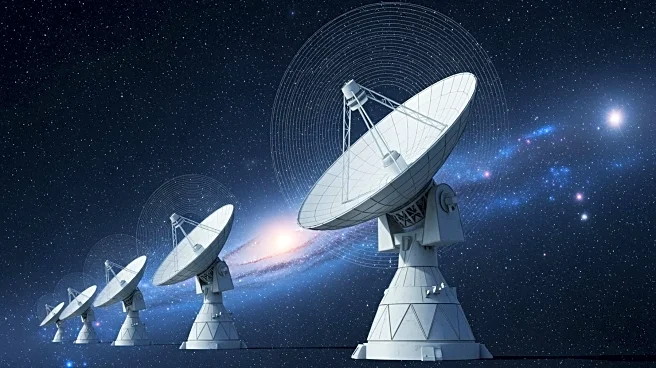What's Happening?
Researchers at Tel Aviv University, led by Prof. Rennan Barkana, have proposed a novel method to explore the nature of dark matter by detecting radio waves from the early Universe. Their study, published
in Nature Astronomy, suggests that during the 'cosmic dark ages,' dark matter formed dense clumps that attracted hydrogen gas, which then emitted intense radio waves. This period, occurring before the first stars formed, could be studied using radio telescopes placed on the Moon, where the lack of atmosphere and human interference provides optimal conditions. The research highlights the potential of lunar-based radio astronomy to probe these early cosmic signals, which are otherwise blocked by Earth's atmosphere.
Why It's Important?
This research is significant as it offers a new approach to understanding dark matter, a fundamental yet elusive component of the Universe. By studying radio waves from the cosmic dark ages, scientists can gain insights into the properties of dark matter, which plays a crucial role in the formation of galaxies and stars. The findings could transform our understanding of the Universe's earliest moments and provide a pristine setting to investigate dark matter without interference from later cosmic structures. This could lead to breakthroughs in physics and astronomy, as dark matter remains one of the biggest mysteries in science.
What's Next?
The next steps involve the construction of radio telescopes on the Moon to detect these ancient signals. The global race to return to the Moon, with countries like the United States, Europe, China, and India involved, could facilitate this endeavor. Additionally, the Square Kilometre Array (SKA), a large-scale international project, aims to map cosmic radio intensity variations, potentially revealing the locations of dark matter clumps. These efforts could open a new observational window, leading to surprising discoveries about dark matter and the early Universe.
Beyond the Headlines
The study underscores the importance of international collaboration in space exploration and scientific research. It also highlights the potential for lunar missions to contribute to fundamental scientific discoveries. The research could inspire further technological advancements in radio astronomy and space exploration, as well as foster a deeper understanding of the Universe's origins and the role of dark matter.












